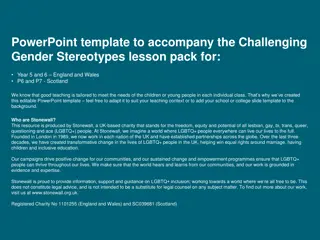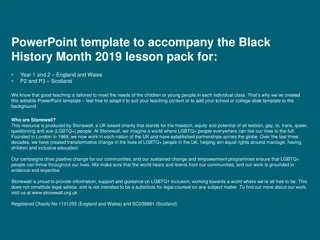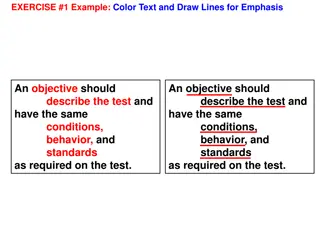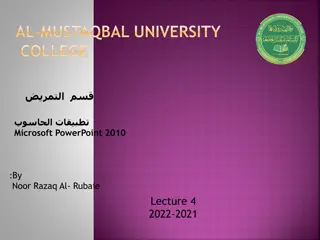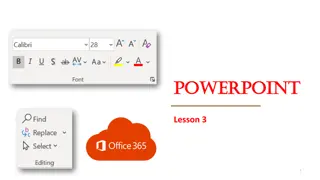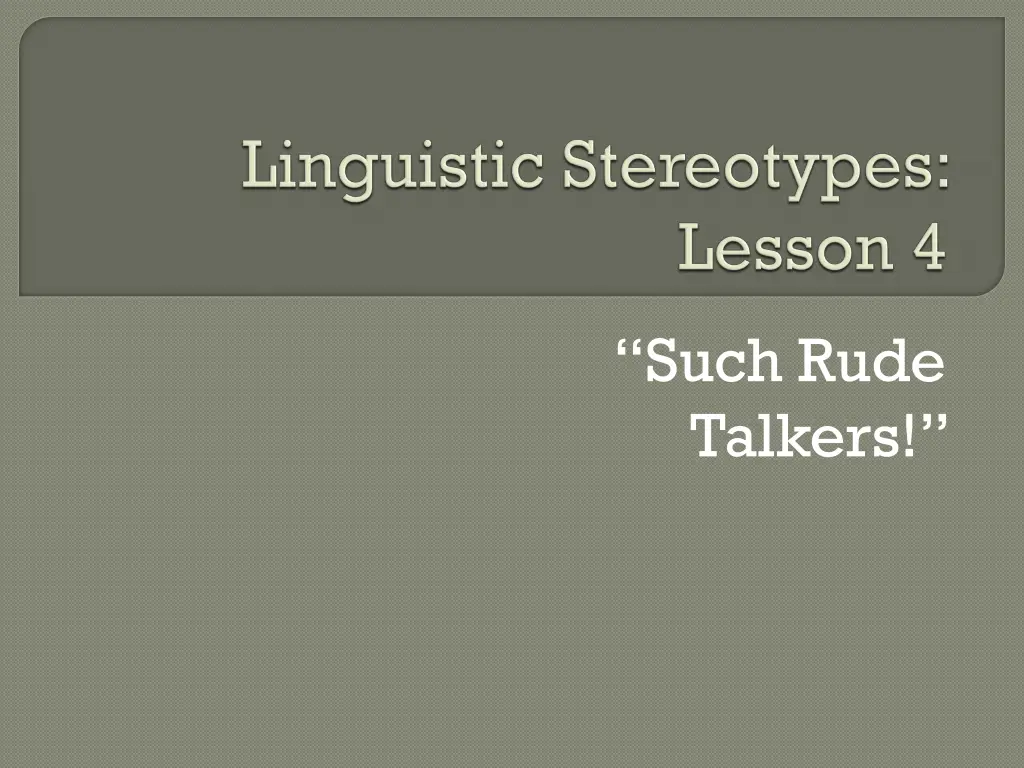
Understanding Rudeness in Linguistic Behavior
Explore perceptions of rudeness based on linguistic behavior, challenge stereotypes, and analyze conversational styles of notorious rude personalities. Rate statements and compare conversational styles in different contexts to understand the role of culture and pragmatics in conversations.
Download Presentation

Please find below an Image/Link to download the presentation.
The content on the website is provided AS IS for your information and personal use only. It may not be sold, licensed, or shared on other websites without obtaining consent from the author. If you encounter any issues during the download, it is possible that the publisher has removed the file from their server.
You are allowed to download the files provided on this website for personal or commercial use, subject to the condition that they are used lawfully. All files are the property of their respective owners.
The content on the website is provided AS IS for your information and personal use only. It may not be sold, licensed, or shared on other websites without obtaining consent from the author.
E N D
Presentation Transcript
Such Rude Talkers!
By the end of the lesson, you will be able to Articulate the common perceptions of rudeness, as determined by a speaker s linguistic behavior; Cite specific linguistic research to challenge stereotypes of rudeness; Connect linguistic behavior to social and cultural perceptions of rudeness; Discuss the linguistic structure and rule-governed nature of conversations.
Notorious Rude People: Watch these clips and rate their conversational styles: https://www.youtube.com/watch?v=Kg6Qpbcmp1s (Sherlock Holmes and Molly) https://www.youtube.com/watch?v=GRo32Ug22HY (Michael Scott and Toby, from The Office) https://www.youtube.com/watch?v=PxuPPaMp250 (Larry David, from Curb Your Enthusiasm)
Some groups of people are just rude. People who talk loudly are rude! People who interrupt are rude! New Yorkers are rude! (Cf. Larry David)
Rate the statements on the previous slide in terms of how well you agree with them, on a scale of 1-5. 1=strongly disagree; 5=strongly agree
Watch these conversations from Woody Allen s film Annie Hall (1977). Compare and contrast the two styles. Is one family ruder than the other? https://www.youtube.com/watch?v=z8TSv Mx2wPI
Think about those people you have conversations with on a regular basis. How would you describe the ones who converse with you easily compared to those whose exchanges with you are bumpy? What variables might be in play in the good and not-so-satisfying conversations?
Conversations are a type of discourse; Discourse is rule-governed; There are pragmatic rules to follow; Pragmatics is culture- and situation- specific, and can make or break a conversation; There is more than one conversational style.
Maxim of Relevance: Maxim of Quantity: Assume the speaker is giving us relevant information Assume the speaker is giving us enough information Maxim of Manner: Maxim of Quality: Assume the speaker is wording his/her sentences so that there are no misunderstandings Assume the speaker is giving us correct information Grice (1975)
When someone violates (flouts) a maxim, he (in this case The Big Bang Theory s Sheldon) gets noticed. Watch this video: https://www.youtube.com/watch?v=vEM8 gZCWQ2w
How aligned are speakers pragmatics - across cultures - by power dynamics and social status (boss vs. subordinate, professor, student) - age/generation - by situation (asking for a favor, negotiating business deals, joking around)?
Check alignment in How loud and close are the speakers Patterns in pacing and pausing Degree of directness Degree of politeness How much interrupting (vs. overlapping) How many turns/how much time per speaker How much back channeling (mm hmm, yeah, uh- huh)
Audio Clips of Backchanneling http://www.cs.utep.edu/nigel/egrunts/m/s tabbing.au
The Close Talker https://www.youtube.com/watch?v=NGVSI kEi3mM&feature=youtu.be The Low Talker https://www.youtube.com/watch?v=BFRoX oh6aks
we might blame the speaker or culture for being rude, instead of blaming a mismatch of style.
Engage in small talk/schmoozing or plunge right into a conversation? Say goodbye, or just hang up the phone? Address someone by title (Ms./Mr./Dr./Prof.) vs. first name? Appreciate terms of affection (Hon, Dear) from a non-intimate? (clerk, doctor, etc.)
How to say no to a request How to respond to a compliment How to respond to a complaint What is joking and teasing vs. criticizing How to deliver bad news How to wield sarcasm How to say what we mean
Look at the lists on the previous two slides of factors we must consider in having conversations. Consider your own conversational style. Share with a classmate.
Has someone just told a joke, or was that an insult, or something in between? How can you tell. Summarize and comment on this Internet discussion: http://english.stackexchange.com/questio ns/80171/what-is-another-word-for-an- insult-when-you-want-to-joke-or-play
Do people really say what they mean and mean what they say? Conversations have a message and a meta-message. Illustrate the point by viewing this dual-level conversation from Woody Allen s Annie Hall (1977). https://www.youtube.com/watch?v=qLblw VUEHyw
Our internalized knowledge of how to use language to fit in with our speech community is called our communicative competence. Communicative competence allows us to be pragmatic in our language behavior, as both speaker and listener.
Backchanneling supportive overlapping with the speaker, not seen as interrupting Taking turns appropriate number of turns, amount of time per turn Responding in contingency pairs (thank you = you re welcome)
Look for negative evidence evidence that we have been misheard or misunderstood If no negative evidence, assume we have been understood We usually go further, looking for positive evidence of understanding
So, are people rude talkers? OR Are they using cultural or personal pragmatic norms? Pragmatic norms vary widely among people and cultures. Misunderstandings and assumptions about rudeness can result from clash of pragmatics.
Reflect on a conversational exchange (or one in writing) that you had recently that did not go well. Can you consider the pragmatics of the event and think of the exchange in a new light?
Consider those rude New Yorkers! What can you say from the linguistic point of view about the conversational norms of New York residents? Use the information in the following links: http://www.pbs.org/speak/seatosea/america nvarieties/newyorkcity/ https://www.dauntlessjaunter.com/2013/10/0 2/new-yorkers-rude-a-look-at-speech- patterns-in-nyc/
Some groups of people are just rude. (1- 5) People who interrupt are rude. (1-5) I am a good listener. (1-5) 1=Strongly Disagree; 5=Strongly Agree One fact/slide/image/link that resonated with me

